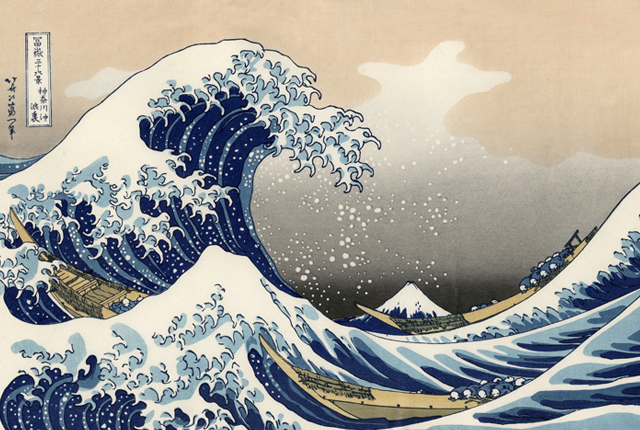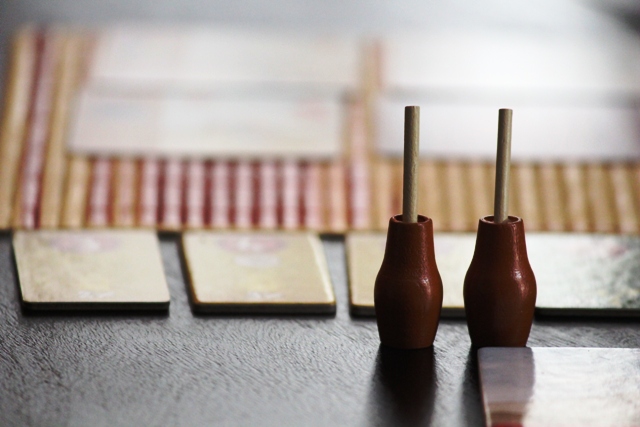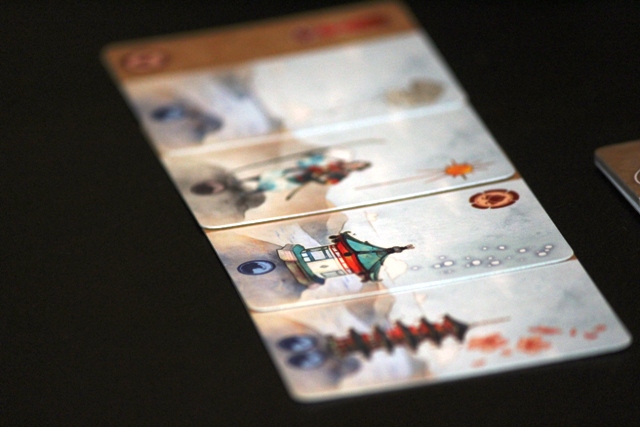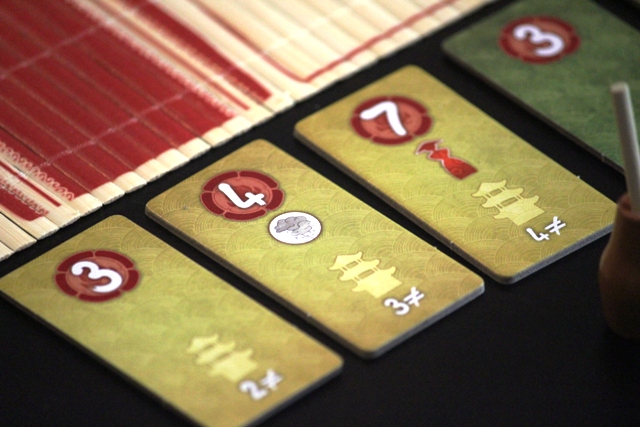Kanagawa Review

What is it? One of the myriad reasons I adore this hobby of ours is because of the way it can showcase certain themes and elements that both adds excitement to activities we might ordinarily find rote, or provide a deeper appreciation for skills we don't necessarily possess. Kanagawa aims to both educate and engage us in the ukiyo-e style, as players vie for the position of apprentice to the master himself, Katsushika Hokusai.
It seems like we’ve been talking an awful lot about drafting games of late. Sure it’s certainly a mechanic we enjoy, but it’s also one that seems to slot well in a variety of scenarios. And not unlike the volume dial of a radio, it can be turned up until it’s the only thing you hear thumping through the speakers, or low enough that it’s a pleasant sonata hovering just beneath the conversation.
Kanagawa certainly belongs to the latter category, and that’s not the only aspect that lends the game a decidedly cultured feel. Kanagawa is a prefecture in Japan boasting a rich history in art, for which it is probably most well known as the most famous of the artist Hokusai’s work, an exquisite woodblock print entitled The Great Wave off Kanagawa. You happen to be one of his disciples, intent on learning all you can in his newly opened school, creating a harmonious print that might one day rival the works of your Master himself.
And that sense of harmony and order is evident from the moment you lay hands on the box. From the gorgeous cover art to the meticulously ordered insert, the component quality is outstanding. And the bamboo-styled board is a touch of class. The art on the cards themselves I imagine may be polarising, I appreciate that not everyone will resonate with it but I certainly did – tranquil, detailed and just so pleasing to the eye.
But it’s not just the components that promise to excite, Bruno Cathala and Charles Chevallier are no strangers to boardgame design having worked together on the excellent Abyss, but Cathala alone has a dozen titles to his name. There is a sense of familiarity to certain aspects of gameplay, but Kanagawa is equally quite unlike anything I’ve played before. Master Hokusai has left an indelible mark on the history or art, will Kanagawa leave you with a similarly memorable experience?
The object of the game is relatively simple, work through the deck of Lesson cards by adding them to your tableau, creating a panorama that will hopefully score you the most points at the end of the game, which is triggered once the deck of Lesson cards is empty. These cards are added to your tableau in one of two ways – either as an addition to your studio which improves your ability to paint both more and a greater variety of images, or as an addition to your painting itself.
Lesson cards are added to the board spaces face up or down as indicated, limited by the number of players. Then in turn order players choose a card or pass. Passing can be both an extremely powerful decision and a highly risky one, as a new row of cards is drawn once all players have decided to choose or pass and should at least one player have passed. The remaining students who then choose a card take all the cards in the row of their choice. So it’s essentially choose first and select a card you are certain you can use, or pass and hope that having two or more cards at your disposal will increase your strategic options. In a four player game, it’s possible to collect 3 cards in a turn.
Cards used to expand your studio are added to your starting studio card, and provide you with one or more paintbrush slots. All cards that you may potentially add to your masterpiece belong to a lesson category, with blue representing animals, green representing trees and so forth. If you want to paint a particular card, you need the matching paintbrush slot in your studio. Players begin with with two brushes, but once a brush is assigned to a slot it remains there unless a game function allows you to move it, which in turn means that you’ll be adding brushes to your studio as the game unfolds. But cards added to your studio also provide additional functionality over and above the brush slot, with certain cards as I mentioned adding more brushes and others allowing you to move certain brushes from an occupied slot to an empty one.
And if you’re lucky, you’ll find a studio card that allows you to keep a Lesson card in your hand from one day to the next. Yip, as you may have guessed, if you do end up with 3 cards you have to use all 3. This is where the risk element comes into play, as it may force you to add a card at a time that is most inopportune. The last icons that need mentioning are the Assistant which means you will be the first player at the start of the next turn, and the Harmony icon which is Kanagawa’s currency for victory points. Certain Harmony icons will have a slash through them, which means points will be deducted from your total at the end of the game, but these are usually associated with powerful studio effects such as a brush slot allowing you to paint from any category.
The major source of Harmony points however won’t be found on Lesson cards, but instead players will need to earn diplomas. There are 2 diplomas per category, and a player is only eligibly for one diploma from each. Diploma’s can be claimed as soon as a player qualifies for one, but if they choose instead to pass they can no longer claim the diploma for that level. A quick example should illustrate more clearly: the Building diploma awards points at three intervals, 3 points for having two different buildings in your masterpiece, 4 points for 3 different buildings and 7 points for 4. The moment you place a third unique building you must either claim the 4 point diploma or pass and hold out for the 7 point one, but if you do so you are not allowed to claim the 4 point diploma at a later stage.
Finally, all landscape cards are assigned to a season such as Spring or Fall – players will score extra Harmony points for the longest run of consecutive seasons in their masterpiece. There are 3 storm tokens which are granted as bonuses by certain Diplomas, and these act as wilds altering any card in your landscape to the season of your choice. The player in possession of the Master marker (first player marker) also gets an additional 2 Harmony points. Tally up, deduct where applicable, and Master Hokusai’s new apprentice is revealed.
That’s about as simple a run through as I reckon I’m capable of providing, and you’ll have noted that there’s quite a bit more going on beneath the box cover than you may have guessed. Things may seem tranquil on the surface, but despite Kanagawa’s focus on crafting a zen-like facade, there are some interesting decisions to be had where timing intersects with risk.
I mentioned a sense of familiarity earlier, and given that Kanagawa is essentially a set collection game there are certainly whispers of Abyss. When to snatch up a card that is clearly beneficial, or press your luck for the promise of even more, when to snag an early diploma and get points on the board or plan carefully to secure a 7-pointer. It’s rather impressive really just how much is happening from one turn to the next – drafting, worker placement, press your luck, tableau building – sure it’s on the lighter end of the scale, but it’s the way in which Cathala and Chevallier have expertly blended the hues together. Art is so often about avoiding the trap of a fleeting first glance, but rather lingering before the canvas like Cameron standing in front of A Sunday on la Grande Jatte (that’s a Ferris Bueller reference), allowing the hidden intricacies time to reveal themselves.
Where Kanagawa does stumble slightly is with pacing. If the first player simply grabs and plays a single card, the wait for the next few players to potentially play more than one card can prove somewhat unwieldy. It’s not that downtime is significant, but more that for the length of the game and the fact that it’s been positioned as a light 45 minute experience, the game doesn’t always develop a steady rhythm. My other moderate gripe is with the rules. Whilst I appreciate the effort to align the rules thematically with the gameplay in terms of listing the various steps in the context of a living, breathing art school, this leads to unnecessary complications. The rules took far longer to puzzle out than they should – I’m all for injecting personality into rules, but not at the expense of readability.
Kanagawa for me inhabits the same territory as Takenoko, although in my opinion outshines it. I’m not sure whether it would appeal as a gateway game in the same way Takenoko does, but there’s far more on offer here. The draft aspect adds a similar pinch of randomness as a die would, but I feel more in control of my actions – when I take a risk I do so at my own behest and not because a die has forced my hand. The range of diplomas is sufficient so that I feel as if I have options, but constrained enough that players will often clash over them.
A masterpiece is the product of an intangible mix of preparation and inspiration, and Kanagawa reflects that with surprising accuracy. As much as you may plot out the shape and feel of your artistic vision, just as often things will veer off in unexpected directions and you’re relying solely on your skills as a painter to keep up.
Many thanks to Solarpop Distributors for the review copy
Pros:
- Top notch components
- Excellent melding of theme and mechanics
- Good depth vs time ratio
Cons:
- Pacing issues
- Not as good at 2
- Rulebook needs simplifying










